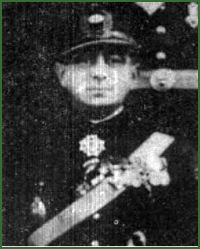Constantin Petrovicescu

Constantin Petrovicescu (Romanian pronunciation:
A sympathizer and secret member of the fascist Iron Guard movement, he was also the royal commissioner involved in the 1934 acquittal of Guard leader Corneliu Zelea Codreanu. Petrovicescu was assigned his ministerial position by Codreanu's successor Horia Sima, serving as one of the main Iron Guardists in the conflicted cabinet headed by Ion Antonescu. In this capacity, he helped Sima obtain control of an armed structure, and, taking the party's side during the Legionnaires' rebellion of 1941, helped organize it in combat against Antonescu.
Captured and tried, Petrovicescu spent the longer part of World War II in confinement or house arrest. He was retried for war crimes two years after King Michael's Coup of August 1944, and sentenced to life imprisonment. He died in Aiud Prison almost two years after a Romanian communist regime had been established.
Biography
Born in
After being named
Two years later, following Carol's abdication and the assumption of power by General Ion Antonescu and the Guard (together ruling a National Legionary State, with Antonescu as Conducător and Prime Minister), the new ruling party recommended Petrovicescu as Interior Minister, and he assumed that post. In October 1940, upon the recommendation of vice premier and new Legion head Horia Sima, Antonescu promoted Petrovicescu to the rank of divisional general retroactive to June 1, 1938, and returned him to active duty.[3] As minister, he worked with Sima to create a well-armed Legionary police force, and actively supported arresting or even killing politicians who in the past had suppressed the Guard.[4] The new police force also turned itself into a tool of racial repression, targeting the Jewish-Romanian community.[5]
Petrovicescu irritated Antonescu by upholding public acts of violent retribution, and this fall-out acquired importance by the close of 1940. In particular, the Conducător suspected his Legionnaire subordinate of having played a part in organizing the
Petrovicescu was an important destabilising element during the subsequent events, which saw his and the Guard's fall into disgrace.[3] He is believed to have had the personal initiative for one of the most notorious acts of violence carried out at the time, by ordering the Legionnaires to occupy the headquarters of the Siguranța Statului secret police and open fire on the soldiers and civilians outside.[11] Petrovicescu was arrested and tried along with other former Legionnaire government officials. In summer 1941, he was sentenced to five[3] or seven[12] years' imprisonment. In 1944, he was sent to Sibiu to live under house arrest.[13]
Following the
Notes
- ^ a b c Neagoe, p. 570
- ^ a b Ornea, p. 300
- ^ a b c d e Neagoe, p. 571
- ^ Deletant, p. 60-61, 66; Neagoe, p. 571
- ^ Deletant, p. 60
- ^ Deletant, p. 61
- ^ Deletant, p. 64-65; Ornea, p. 343
- ^ Deletant, p. 64
- ^ Deletant, p. 65
- ^ Deletant, p. 299
- ^ Deletant, p. 300
- ^ a b Deletant, p. 302
- ^ Deletant, p. 302; Neagoe, p. 571
- ^ Deletant, p. 347; Neagoe, p. 571
References
- ISBN 1-4039-9341-6
- Stelian Neagoe, Oameni politici români, Editura Machiavelli, Bucharest, 2007. ISBN 973-99321-7-7
- ISBN 973-9155-43-X
